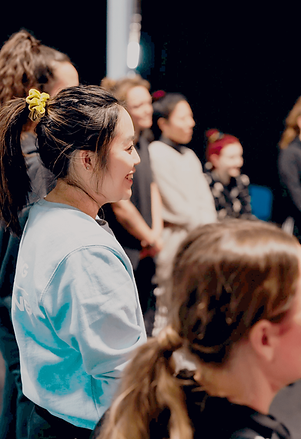Pain advice: a new framework for acrobatic performers and acrobatics athletes
- Bethany Shum

- Sep 4, 2024
- 6 min read
Updated: Sep 23, 2024
Your Ultimate Guide to Pain Management for Acrobats and Cheerleaders
Blog by Bethany Shum, BSc Physiotherapy, MSc Performing Arts Medicine
Have you ever watched an acrobatic performance and wondered what the performers have been through to deliver a flawless routine?
Acrobatic performers create incredible movements because their bodies are resilient and robust; however, it comes at a price.
The term "Acrobats" includes a wide variety of acrobatic disciplines. Circus Arts, Aerial Hoop, Aerial Silks, Gymnastics, Tumbling, Cheerleading, acro dance, and acro sports are the most common. These are often integrated into a routine that requires balance, coordination, strength, and dynamic movements. As these activities require a high physical demand, pain is a common experience in acrobatics.

Circus acrobatic performer demonstrating a human pyramid (Almedia,2014). Picture from Pixabay.
There is interest in pain and injuries in acrobatic athletes; however, there is limited research and healthcare access for acrobats. Acrobats who suffer from pain may find that it can impact their training, performance, and mental health. Therefore, health research suggests we should consider biological, psychological, and social components when managing acrobats’ pain.

“No pain, no gain.”
It is common for performers to perceive that unless there is “no pain,” there is “no gain.” For those who share this belief, pain is required to progress their training and be successful as acrobatic performers (Tynan and McEvilly 2017; Watt 2022).
Perhaps this “no pain, no gain” mindset makes the pain more bearable and encourages performers to push the boundaries and continue to train through pain. Therefore, it is no wonder that the pain conditions are so prevalent. The combination of long training and muscle fatigue can lead to painful injuries.
This determined and hardworking mindset may help keep acrobats motivated in their training in the short term. However, this approach may lead to pain desensitization in the long term. This increases the risk of injury and overuse, resulting in conditions such as repetitive strain syndrome.
We should start questioning how accurate the “no pain, no gain’ beliefs are and begin to shift performers’ pain beliefs and guide them with injury and pain prevention strategies.
The current understanding of pain categories in acrobatic performers
Pain can be differentiated into either good “performance” pain or bad “injury” pain. Recent research has indicated a high injury rate in acrobats (Wolfenden and Angioi, 2017). Recently, findings showed that the spine and the ankle are the most frequently injured body regions. Overuse-related pain is commonly also reported, with many experiencing recurrent lower back pain. However, there is limited numerical data, and its impact on an individual’s pain experiences remains unclear. Overall, the current evidence suggests that factors such as being heavier, training for longer hours, undertaking high-risk acrobatic skills, and performance-related stress can all contribute to increasing pain experience and injuries.
The more experienced the acrobats are, the more accurate they are at describing their pain level, cause of pain, and location. In addition, they are generally more able to differentiate between injury and performance-related pain. The figure below demonstrates how acrobatic performers identify their pain.

Normalisation of pain
The human body is the primary tool for all acrobatic performers. Pain is seen as usual and is deemed a part of their acrobat's identity (Tynan and McEvilly 2017).
An elite gymnast's perspective of pain:
“If you want to go far in your career, then you’ve got to put up with the pain […] Pain can be a niggle; it’s not going to get any worse, you’ve just got to work through it” (Tynan and McEvilly 2017).
An aerial acrobat's perspective of pain:
“Pain is the physical and psychic tattoos of my practice” (Watt,2022).
“No pain, no gain, you know, it’s kind of like a badge of pride.”
Research on aerial acrobats found that pain and physical discomfort play a role in developing their body awareness and are an essential part of progress in their training (Watt,2022). In addition, pain can provide a sense of achievement and be an embodiment experience. Consequently, they will often continue performing with pain. With strong willpower and confidence to achieve their goals despite pain challenges, this coping method is called high pain self-efficacy in psychology.
Generally, it is common for acrobats to accept and ignore pain for various reasons. Their desire (e.g., internal motivations), pressure from themselves (e.g., perfectionism traits), pressure from others (coaches), financial stressors (e.g., low pay), and performance lifestyle (regular performances with a limited rest day) can all lead to “pushing into pain” behaviors. Thankfully, several ways exist to reduce aches and pain and optimize their body. However, it is vital to self-identify pains that require medical attention.
Pain that requires medical attention
As no healthcare system is tailored to acrobats, many pains result in self-treatment. Unfortunately, unaddressed underlying problems such as muscular weakness, fatigue, muscle overactivity, and reduced coordination can all lead to pain and increase the risk of injuries. In addition, sometimes pain can be caused by factors unrelated to activities. Therefore, knowing possible signs and symptoms that require medical attention is vital.
Please seek medical advice if you experience the following signs and symptoms:
· Sudden onset of severe pain
· Pain that does not improve with rest and worsens over time
· A change of sensory feelings (numbness and tingling feelings)
· A reduction in joint range of movements
· Body deformities along with trauma
· Aching night pain and unexplained weight loss
· Pain that limits your everyday life
In addition, if you are worried about your pains and struggling to cope, it is also worth seeking professional care advice.
Free resources for acrobats: BAPAM (British Association for Performing Arts Medicine) is a charity that provides resources and health and wellbeing services for performers (BAPAM 2022). To learn more about this, please visit: https://www.bapam.org.uk/
Takeaway message
A wide range of factors can cause pain, leading to changes in both the mind and body. Physically, pain can lead to muscle deconditioning, altering body coordination and reducing balance. Mentally, it can lead to anxiety, mental fatigue, and frustration about their pain. Therefore, living in persistent pain can lead to a vicious cycle of the mind and body (see diagram below), which may not be helpful sometimes. However, there is hope. Painful conditions can improve if they identify areas for positive changes after an injury or when living in a long-term pain condition. Approaching pain holistically can identify many ways to improve a person’s experience.
To further support acrobats, a proposed framework has been developed from the latest research to increase acrobats, coaches, and clinicians’ confidence when working with acrobats who experience persistent pain.
New framework for pain management
1. Maintaining a healthy physical condition
o Maintaining a healthy BMI (body mass index)
o Consider a mixture of muscular strength and flexibility training
o Ensuring there are rest days during the week for muscle recovery
2. Reviewing training load
o Consider collaborating with coaches, teachers, and physiotherapists to review their current training load and design a progressive loading exercise program.
o Prevent excessive overload and tailor the exercise to meet the individual's acrobatic demands
o Setting out realistic goals when developing a new acrobatic skill
3. Stress management
o Noticing the cause of their life stressors
o Planning out realistic actions to manage their stress
o Managing mood and seeking mental health support if required
4. Recognising the types of pain
o Education around early signs and symptoms of injuries
o Understanding why pain occurs
o Knowing how to differentiate “acceptable” and “unacceptable” pain
5. Supporting long-term self-management
o Working with a health professional to reduce pain worries
o Improving confidence to self-manage pain
o Knowing when and where to seek health advice
o Signposting towards self-help and pain identifications
While there are various types of acrobatics disciplines, participating requires testing the limits of one's human body, potentially causing pain. Therefore, coaches, teachers, and health professionals must consider the acrobat’s beliefs when developing injury prevention and pain management programs to support acrobatic performers’ career longevity.
References
Almedia, I. 2014, Pixabay, viewed 1 Aug 2022, <https://pixabay.com/photos/acrobats-circus-contortionism-412011/>
BAPAM. 2022. BAPAM: Performing Arts Medicine. [online] Available at: <https://www.bapam.org.uk/> [Accessed 1 August 2022].
Tynan, R. and McEvilly, N. 2017. ‘No pain, no gain’: former elite female gymnasts’ engagements with pain and injury discourses. http://dx.doi.org.libproxy.ucl.ac.uk/10.1080/2159676X.2017.1323778 9(4), pp. 469–484. Available at: https://www-tandfonline-com.libproxy.ucl.ac.uk/doi/abs/10.1080/2159676X.2017.1323778 [Accessed: 30 May 2022].
Watt, C. 2022. Social circus in aerials: Female experience, muscularity, pain and trust. https://doi-org.libproxy.ucl.ac.uk/10.1080/19443927.2021.1968025 13(1), pp. 136–152. Available at: https://www-tandfonline-com.libproxy.ucl.ac.uk/doi/abs/10.1080/19443927.2021.1968025 [Accessed: 30 May 2022].
Wolfenden, H.E.G. and Angioi, M. 2017. Musculoskeletal injury profile of circus artists: A systematic review of the literature. Medical Problems of Performing Artists 32(1), pp. 51–59. doi: 10.21091/MPPA.2017.1008.



.png)





Comments